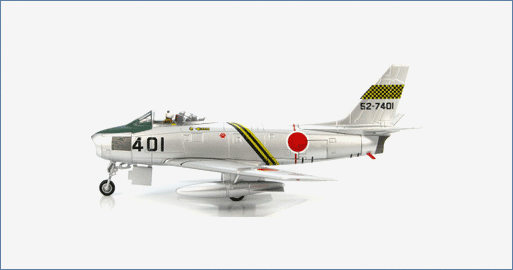Air Power Series>1:72 die-cast display model>F-86>HA4304
North American F-86F-30 Sabre 52-7401, 1st Squadron, JASDF, 1956

General Background
The North American F-86 Sabre was manufactured from 1949 – 1956 and was America's first swept-wing fighter. As well as being built in the U.S. variants were built in Canada and Australia bringing the total of all variants manufactured to 9,860 units. During the Korean War the Sabre arrived to take on the other swept-wing aircraft of the conflict, the MiG-15 Fagot. The Americans claim they shot down 792 MiGs while only losing 78 Sabres, a 10:1 victory ratio which is greatly disputed.
The Aircraft
In late 1953 most Allied forces decided to let Japan rebuild its military and the F-86F was chosen
as the aircraft for the job. Surplus USAF aircraft were delivered but eventually Mitsubishi was
permitted to assemble them at Nagoya. Even though a large number of aircraft were supplied
only a total of 480 F-86Fs were actually flown by Japanese pilots due to a shortage of eligible
pilots. These F-86Fs equipped Hikotais 1 to 10 and eventually were used by the "Blue Impulse"
aerial display team. F-86F 52-7401 was the first aircraft sent to Japan.
Specifications :
| Crew: | 1 |
| Dimensions | |
| Length: | 37 ft 1 ins (11.4 m) |
| Wingspan: | 37 ft 0 ins (11.3 m) |
| Height: | 14 ft 1 ins (4.5 m) |
| Weights: | |
| Empty: | 11,125 lb (5,046 kg) |
| Loaded: | 15,198 lb (6,894 kg) |
| Maximum Take-off: | 18,152 lb (8,234 kg) |
| Powerplant: | 1 – General Electric J47-GE-27 turbojet |
| Thrust: | 5,910 lbf (maximum @7,950 rpm for 5 minutes) 26.3 kN) |
| Fuel: | JP-4 |
| Internal: | 437 US gallons (1,650 l) |
| Drop Tanks: | 2 x 200 US gallons (760 l) |
| Maximum Speed: | 687 mph (1,106 km/h) @ sea level and combat weight of 14,212 lb (6,447 kg) |
| Range: | 1,525 miles (2,454 km) |
| Service Ceiling: | 49,600 ft @ combat weight (15,100 km) |
| ROC: | 9,000 ft/min @ sea level (45.72 m/s) |
| Armament: | |
| Guns: | 6 x 0.50 in (12.7 mm) M2 Browning machine guns w/1,602 rounds |
| Rockets: | various rocket launchers, example 2 x Matra rocket pods w/18 SNEB (French
manufacturer - Societe Nouvelle des Etablissements Edgar Brandt) 68 mm air-to-ground rockets per pod |
| Bombs: | 5,300 lb (2,400 kg) of payload on 4 outer hardpoints while 2 inner pylons were designed for 2 drop tanks to extend range. A variety of bombs could be carried with standard maximum load of 2 x 1000lb bombs on outer pylons plus 2 x 200 US gallon drop tanks on the 2 inner pylons. Napalm canisters and even tactical nuclear weapons could be selecte |

